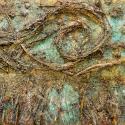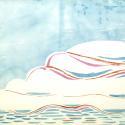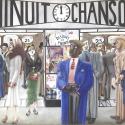In the mid 1940s when the Queen Mother purchased Paul Nash’s Landscape of the Vernal Equinox (1943) Princess Margaret remembers saying, “Poor Mummy’s gone mad. Look what she’s brought back.” But though this painting is one of the undoubted masterpieces of 20th-century British art, it’s easy to see why the Princess responded as she did. At a glance, the dry, scrubby brushwork, muted colours and somewhat lumpen forms don’t exactly sing out of the grandeur of the English countryside in the way that, say, the paintings of Samuel Palmer or John Constable do. But Nash was a metaphysical poet as much as he was a painter, with little interest in mere verisimilitude or the mercurial effects of light. What stopped him just being a romantic landscape painter was, firstly, the strange visions of the Surrealists, and secondly, his experiences during the First World War.
The walls of the Dulwich Picture Gallery have been painted an appropriate stormcloud blue-grey; a colour both aesthetically and psychologically appropriate. Aesthetically appropriate because this sombre hue recurs over and over again as part of Nash’s typically restricted English palette. And psychologically appropriate because many of the works on show (spanning the whole of Nash’s 30-year working life) present us with an unsettled and unsettling world, neither one we are fully familiar with, nor one in which the imagination completely dominates.
The curator of The Elements, David Fraser Jenkins, has wisely avoided a straightforward, linear approach, instead giving each of the exhibition’s four rooms a theme: "Elements in Conflict", "A Path through the Elements", "Elements as Refuge", and "Elements in Harmony". And even though the work is thankfully never so accommodating as to fit neatly into any of these categories, it does mean the gallery can avoid having all the weaker more illustrative early works in one room. But what is interesting about Nash’s early works is the presence of people in them. Later he must have realised that they were diminishing the impact of his vision, because neither man nor dog, nor even sheep, haunts his mature landscapes (although birds are sometimes utilised for compositional or symbolic effect.).
But to return to the Queen mum’s favourite. If you stand before Landscape of the Vernal Equinox for any length of time its subtle beauty should gradually seep into your bones. That flat, scuppered surface of khaki and olive greens, cement-greys and wet-sand-yellows will dissipate under your focused attention, becoming a window onto a world ruled over by a huge snowball of a moon and a rust-red sun. This is landscape approached in much the same way as Nash’s contemporary Francis Bacon tackled the figure. Nash may take less savage liberties with a rolling hill than Bacon took with his poor crushed and twisted sitters, but the end result is, similarly, as much a portrait of the artist’s own troubled soul as it is a literal representation of a stretch of his beloved South Downs.

Because Paul Nash served as a war artist during the First World War, and died just after the Second, war can never have been far from his mind. But the power of both his oils and watercolours lies in how subliminally, and therefore effectively, the war features in them. Yes, there are exceptions to this rule, such as the cinematically striking Totes Meer (1940-41) (above, Tate Gallery), in which a sea of mangled German planes glints mutely in the moonlight. But overall, understatement is the key word here. War may be lurking beyond every hilltop grove, but Nash’s love of gnarled old tree trunks, monolithic chunks of stone and salmon-coloured skies allowed him to escape from the everyday into the otherworldly.
Even though we can discern the spirit of De Chirico, Rene Magritte, Samuel Palmer and even William Blake in his detached, enigmatic imagery, the work of these artists has been assimilated rather than imitated. But perhaps his most personal and intimate painting is his least typical. Interior, Pantile Cottage, Dymchurch (1925) is a Bonnard-like view of Paul and his wife Margaret’s airy bedroom. On the floor by the dressing table is a pair of black high-heeled shoes, rendered so impressionistically that they could be mistaken for birds were it not for their domestic context. Even though Paul and Margaret are conspicuous by the absence from this more carefree and sensuous work, they feel touchingly present. Perhaps because this painting feels like the only glimpse we get of a side of Nash’s life not haunted by the spectre of the battlefield.
Paul Nash, The Elements continues at the Dulwich Picture Gallery until 9 May.





![SEX MONEY RACE RELIGION [2016] by Gilbert and George. Installation shot of Gilbert & George 21ST CENTURY PICTURES Hayward Gallery](/sites/default/files/styles/thumbnail_125_x_125_/public/mastimages/Gilbert%20%26%20George_%2021ST%20CENTURY%20PICTURES.%20SEX%20MONEY%20RACE%20RELIGION%20%5B2016%5D.%20Photo_%20Mark%20Blower.%20Courtesy%20of%20the%20Gilbert%20%26%20George%20and%20the%20Hayward%20Gallery._0.jpg?itok=3oW-Y84i)









Add comment